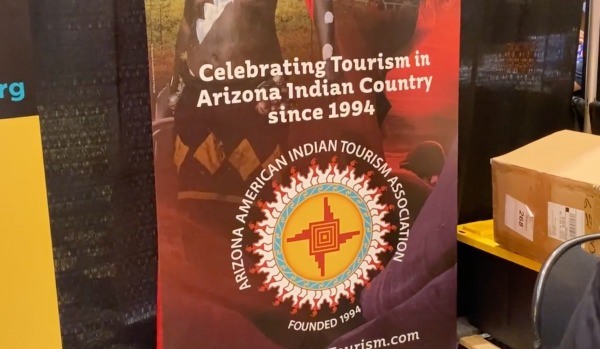News Based on facts, either observed and verified directly by the reporter, or reported and verified from knowledgeable sources.
INDIGENOUS TOURISM AN ECONOMIC POWERHOUSE
 Sign at the American Indian Alaska Native Tourism Association annual conference held near Phoenix in October 2021. (Screenshot from video by Patty Talahongva, Indian Country Today)
Sign at the American Indian Alaska Native Tourism Association annual conference held near Phoenix in October 2021. (Screenshot from video by Patty Talahongva, Indian Country Today)
Indigenous-owned tourism businesses contribute billions to the U.S. economy.
That’s according to a first-of-its-kind study by the American Indian Alaska Native Tourism Association and Honolulu-based SMS Research. The study was released at the association’s annual conference held at the Fort McDowell Yavapai Nation’s We-Ko-Pa Casino Resort near Phoenix.
“This is the first time that we’ve analyzed the U.S. Census data for 2017 in order to show specifically the race and ethnicity categories of Native American, Alaska Native and Native Hawaiian,” said SMS Research Executive Vice President Daniel Naho‘opi‘i, Kānaka Maoli (Native Hawaiian).
“We found that coming out of the Great Recession from 2012 to 2017, Native-owned businesses improved about 7 percent in growth, but Native-owned tourism businesses had a growth rate of 19 percent. So tourism does work,” Naho‘opi‘i said. While 36 percent of the Indigenous-owned businesses are in retail, 31 percent are in transportation and warehousing, 21 percent in arts, entertainment, and recreation, and 12 percent in accommodations and food.
And, “in 2017, American Indian-Alaska Native-Native Hawaiian-owned tourism firms’ annual sales contributed close to $14 billion to the U.S. economy,” said the American Indian Alaska Native Tourism Association in a prepared statement.
“That’s a huge number for us before we didn’t even know really what the economic impact was. And so to be able to have that number is really important for us as we advocate locally, statewide, and nationwide on behalf of tribal tourism,” said association CEO Sherry L. Rupert, who is Paiute/Washoe, speaking to Indian Country Today.
“This report confirms that Indigenous tourism businesses in the U.S. are an economic powerhouse,” Rupert said.
“For too long, the Native hospitality industry has not had hard data to back up the perceived value of its economic impact, so we are delighted to release this study. We are especially thrilled to learn that more than one in four Native-owned businesses are hospitality businesses,” said Naho’opi’i.
“We’ve also found that even though Native tourism businesses may be smaller than your average general mainstream tourism business, Native tourism businesses are actually more successful than your typical Native business here in the United States. So tourism is more successful than some of the other sectors in the Native businesses right now,” said Naho‘opi‘i.
He said Native businesses can use the data to show funding sources that Indigenous tourism can succeed. “We’re using U.S. government data to show our wealth and our worth so they (businesses) can take that to be used in their grants, and when they’re working with federal programs to show that tourism actually works,” Naho’opi’i said.
Rupert said businesses are beginning to re-open, although the impacts of the pandemic have been “devastating” for some. She said, “our Native artisans have had a difficult time because they’ve not had the venues like this conference to be able to sell their art.”
Business owners are also grappling with the same worker shortage as the larger communities they’re in. “I know that they’ve found resourceful ways in which to make sure that people traveling to Indian Country still get that authentic experience while they’re there,” Rupert said.
In addition to releasing the study, conference organizers announced the association had signed a 5-year agreement with the National Park Service to “ensure that the perspectives, voices and traditions of Indigenous communities are incorporated into exhibits, outreach and cultural tourism programs in national parks,” said a park service statement.
One of the presenters at the Indigenous tourism conference was Bobbie Chew Bigby, Cherokee Nation. The conference program said as a PhD Fellow, Bigby “believes in the potential of tourism for strengthening ties to traditional culture, language and connection to lands and waters.” Her research has taken her to Aboriginal Australia, Burma, Cambodia, China and India.
She told Indian Country Today, “tourism is not only a career or a livelihood for being able to feed your family and making a paycheck earning a paycheck, but also being able to use tourism to again, stay connected with your community, with your culture and staying in your traditional country.”
She said the annual American Indian Tourism Conference is a great learning opportunity, and a psychological boost.
“A lot of us here at the conference have talked about just what a special and exciting opportunity this has been to come together in person again, following all safety protocols and being as careful and safe as possible, but just what a difficult past 20 months it’s been for all of us, all of our families, all of our communities with the number of loved ones and friends that we’ve lost, this is really just a special and almost sacred time of coming together and talking about building a better and brighter future from all that we’ve learned from COVID. So we’re just very, very excited and grateful to be here,” said Bigby.
Indian Country Today is a nonprofit news organization that covers the Indigenous world with a daily digital platform and weekday broadcast with international viewership. https://indiancountrytoday.com/
